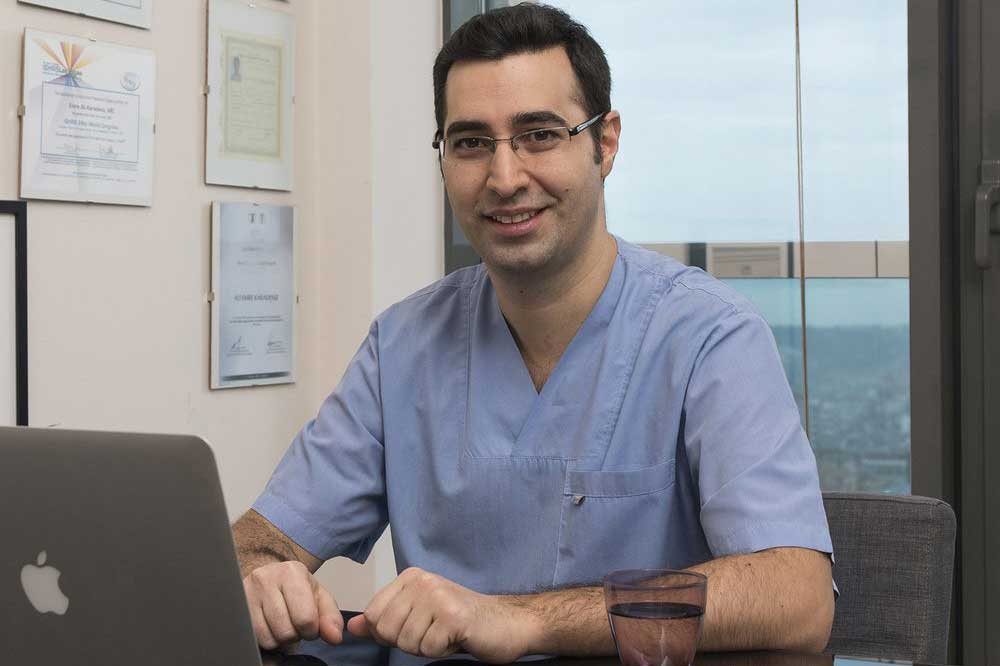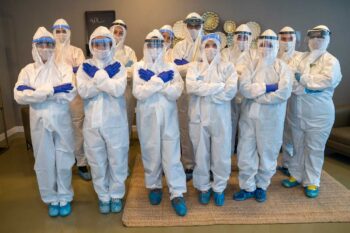
Turkey is the number one destination in the world for having a hair transplant. It is estimated that there are over 1000 hair transplants performed in Turkey each day.
AEK Hair Clinic is a boutique hair transplant clinic in Turkey specialized in providing affordable and high quality hair transplants for international patients.
The AEK Hair Transplants Team is the most experienced and hair transplant team in Turkey that has been trained by Dr. Karadeniz to provide high quality procedures. They have been producing consistently good results for over ten years.

Plastic surgery in Turkey, is an additional 6 years of surgical training over the 6 years of medical school and is the only field of medicine that provides in depth training in cosmetic surgery and tissue reconstruction using grafts. Dr. Ali Emre Karadeniz is the only ABHRS certified Turkish plastic surgeon in the world. Dr. K is also the only Turkish plastic surgeon in the world who has earned the FISHRS status.

We never use ‘freelance rotating technicians’ or technicians that learned what they do elsewhere, unlike most other hair transplant clinics in Turkey. The whole AEK Hair Transplants Team was directly trained by Dr. K and has not only provided consistently good results for years, but also has been making sure that the valuable donor area of each patient is protected for possible future sessions.

There are very few centers in Turkey that are exclusive for surgical hair loss treatments. AEK Hair Clinic was founded by plastic surgeon Dr. Ali Emre Karadeniz who has devoted all his attention to hair restoration surgery. We are able to deal with the most sophisticated hair loss patients who may require a combination of surgical techniques.
Dr. K believes that the fight against hair loss can not be done by providing just an ‘off-the-shelf hair transplant’; it requires philosophy. AEK’s hair transplant philosophy consists of understanding the progressive nature of hair loss, the management of donor hair capacity, a multi-staged hair transplant plan and design that produces the most natural result long term. It includes training of the surgical team who understand the tissue, in order to cause the least amount of tissue damage, the best healing and most natural results. Finally, all of these must be surrounded by an understanding of medical ethics.
FUE is the individual harvest of follicular unit grafts using a sharp metal tube called a 'punch'. Small punch holes are left behind at the donor area which heal on their own within a few days. The most important determinant of the quality of FUE is the training and surgical skills of the surgical team.
FUE HAIR TRANSPLANT IN TURKEYFUT is based on removing a skin strip from the back of the head and the donor area closed with stitches. The skin strip is then cut into individual follicular unit grafts under microscopes which is a very sophisticated procedure. This is why AEK is the only clinic in Turkey that provides high quality FUT hair transplants.
FUT HAIR TRANSPLANT IN TURKEYThe FUT+FUE combination treatment is a very effective option when trying to maximize the yield of donor hair harvesting in a single visit while causing the least amount of tissue damage. It is also the most effective option in repair cases where prior surgeries have exhausted donor resources and caused scarring.
FUT+FUE HAIR TRANSPLANT IN TURKEYHair restoration surgery is based on harvesting hair from an individuals donor area that is located at the back of the head and sides where permanent hairs are found, and then transferring them to a recipient area that is balding.
When you have a hair transplant in Turkey, 99% of consultations and surgeries are done by unlicensed technicians - which are from different backgrounds such as ambulance drivers, paramedics, nurses or housewives -, while our clinic is one of the rare institutions where a plastic surgeon does all consultations and supervise surgical procedures.
The majority of hair transplant procedures are performed under local anaesthesia. This is similar to having a dental treatment. The first few aesthetic injections might be felt, but the whole surgical field becomes numb for the rest of the procedure, which means that a hair transplant is mostly a painless procedure.
Two or three nights stay is sufficient to have a hair transplant in Istanbul.
This is a very complicated question. The cost of a hair transplant depends mostly on the the qualifications of the surgical team and the number of educated labour spent. Most hair transplants in Turkey are done by a pair of technicians, which explains why it can be so cheap. Naturally, a surgical team consisting of an experienced surgeon and a few highly trained technicians costs much more. Hair surgery is 'service' and when the price is below a certain threshold, it is possible to get harm with ones own money. This is different than buying an instrument such as a car or a mobile phone when even the cheapest of all guarantees a minimum standard.
Our clinic offers the best price and quality for each of the above categories.
Patients must follow the instructions of their surgeon immediately after surgery, which are pretty basic. Unless something unusual is done, not much could be done to effect the final outcome of the procedure. Hair transplants are relatively safe procedures and the success mostly depends on whatever is done during surgery. The patient has little influence on the result after that.
Depending on each individual case, a hair cut may be possible 1-2 weeks after a hair transplant. A guarded trimmer could also be used 2 weeks later. However, razor-shaving should be avoided after a hair transplant which could be harmful.
The head is usually washed at the clinic the day after surgery. The patient may be instructed to have a shower 1-2 days after surgery depending on the case.
In general, swimming should be avoided for 10-14 days after a hair transplant.
FUT Hair Transplant (strip surgery) can be done unshaven. There are a few options for FUE;
Transplanted hairs are the patient's hair and they behave no differently than the non-transplanted hairs. When done professionally, a transplant should look as natural as non-transplanted hair and any hair style should be possible.
The terms 'warranty' or 'guarantee' are for instruments and should not be used for surgery. There can be no guarantee of a result and offering this should be considered unethical. Instead, we take 'responsibility' at our clinic. This means that we will take responsibility for the treatment we do and do everything to solve a problem if it occurs. We may offer any help to a patient who is not happy with his/her result, including free touch-up procedures or money refunds. We make sure that our patients feel we were fair in dealing with their complaints and err on the side of making an offer even if the complaint does not relate to a failure.
There aren't important restrictions with regards to the diet after surgery.
Hair transplants are done fully awake, just like dental surgery.
If the surgical design allows wearing a light hat without touching the grafts, then a hat may be used immediately after a hair transplant. However, if a hairline procedure is done, it is not usually possible to wear a hat without risking these grafts at the hairline. It is best to wait a couple of days before a light hat is worn. A wooly hat may be worn 7-10 days later and cap may be used 2-3 weeks later.
There is no adjunct treatment that has proven benefits in combination with or after a hair transplant.
The success of a hair transplant mostly depends on the expertise of the surgical team which should be lead by an experienced surgeon doing the most important steps of the procedure. The most important parameters for success are planning, design and surgical technique. AEK Hair Clinic consists of one of the most experienced and skilled surgical staff in the world.
The duration of a hair transplant depends on the number of grafts transferred as well as the care given by the surgical team on each surgical manipulation and lastly the difficulty of each individual case. Since usually the limits of a surgical day are used to transfer the most number of grafts, an average session takes the whole day and is about 8-9 hours.
When professionally done, it should be impossible to tell that it is a hair transplant result. We are proud to say that none of our previous patients have complained that the result looks unnatural.
The results of a hair transplant are permanent, however since male pattern hair loss is progressive, more transplants may be needed in the future.
We have 2 blog posts related to this topic, you can find detailed information on this topic here:
Patients can travel back home the day after having a hair transplant.
Eyebrow transplants can be even more sophisticated procedures than hair transplants. The four variables in hair transplants are distribution, density, direction and angle; there is an extra variable that needs to be taken care of in eyebrow transplants and this is ‘curvature’. This extra variable makes eyebrow transplants very sophisticated and thus there are a handful of surgeons in the world that are experts in this field. Dr. K is one of them.
For more detailed information, follow the link below:
Practically, the most important risk of a hair transplant procedure is ‘failure’, as life-threatening risks are very little. Failure of a hair transplant may be, some or all of the transplanted hairs not growing, donor damage and depletion and an unnatural looking result. Fortunately, most of these risks can be controlled by experienced clinics, with the only exception of some of the grafts not taking, which requires a bit of help by the nature. The frequency of this complication must be low and the clinic must have an ethical policy in dealing with this situation. The incidence of grafts not taking at AEK Hair Clinic are very low and the patients are guaranteed that if this happens, a free touch-up procedure will be offered or even a refund.
There are no exact age limits for hair transplants, however, age is a very important determinant of estimating the progress of male pattern hair loss. Therefore, age, must change the surgical plan and the younger the age, the more conservative the plan must be. Generally, it would be wrong to transplant a male patient below the age of 20, who has many years of hair loss ahead and the estimation of the progress is very difficult.
All surgical procedures cause scarring. It is a wrong claim that FUE Hair Transplant is a scarless procedure and that FUT Hair Transplant (strip surgery) causes significant scarring. The only difference is that FUE leaves small punctate scars seen as white dots while FUT leaves a linear scar. The logic behind doing hair surgery is using the camouflage advantage of the hair-bearing scalp which can make these scars close to invisible if the procedure is done professionally. AEK Hair Clinic is proud to be one of the best clinics in the world in producing the least scars in hair transplant surgery.
Once we receive pictures of our patient and details on their medical history, we give each candidate our honest opinion on whether it is beneficial to do a hair transplant and also the best method. If we feel that we can not offer a treatment that would give our patient a significant improvement we admit it.
Just like in any other cosmetic surgical procedure, the most important attempt at getting a good result is the first one. The fact that donor hair is limited, makes it even more important that the first surgical treatment is done professionally and valuable donor hair is preserved. AEK Hair Clinic is one of the leading clinics in the world known to do repair surgery, however there are limitations on what can be done after a poor hair transplant especially if the donor area is depleted.
Women can have hair transplants too. However, hair loss in women is more sophisticated that in men as there are many metabolic reasons for hair loss other than male pattern baldness. This requires a thorough investigation of a woman’s condition in order to rule out metabolic and dermatologic conditions which would benefit more from nonsurgical treatments. The exception is traction alopecia seen especially in Afro-women that is not associated with a disease; this condition is perfectly treatable via a hair transplant.
Read more about Hair Transplant For Women
The donor area is where donor hairs are harvested from. It is determined by the surgeon and should be an area that has sufficient density while also away from areas that are effected by male pattern baldness.
The transplanted hair is your own hair which has a normal biologic behaviour. However, in the case when good quality donor hair is transplanted within thinning hair, the transplanted hair may grow at a faster rate due to being in a better biological condition than the existing hair.
The transplanted hair is assumed as being permanent, however in reality, the transplanted hair will stay as long as it is destined to stay. If nonpermanent hairs are transplanted, then they will be lost. The fact that these hairs are transplanted, does not change their life span.
The term 'donor hair' implies that these hairs are permanently donated, in other words, permanently moved to another location. They will not grow back at the donor area. This is why it is very important to make a long term surgical plan and use donor hair economically. Donor hair is finite.
Body hairs have less favourable biologic characteristics compared to slap hair, such that they grow much slower, they don’t grow very long, they are usually single-haired and their caliber is usually less than scalp hair. Beard hair however mostly resembles scalp hair and gives the best result. Although limited coverage is expected using body hairs, it can be used as an extra resource when there is no or little donor scalp hair available.
A hair transplant session usually takes a full day, that is 8-9 hours. Sometimes a second or third consecutive session may be necessary if the surgical plan includes transplanting a lot of hairs.
The recipient area is usually shaven in order to make the recipient incision making and placement more efficient. Sometimes this can be avoided and more time is spent doing the placement. Strip surgery (FUT), which allows rapid graft harvesting without shaving the donor area, may give the opportunity to do a totally unshaven hair transplant. Sometimes, the recipient area is not shaven in FUE too.
We usually see the patient the day after surgery for washing, bandage removal and instructions, however there isn’t much to check or change about the procedure done.
Beard transplants are done by harvesting donor hair from the scalp to restore the beard and moustache.
Read more about Beard Transplant
It is possible to do hair transplants for Afro-patients. However, it is more technically challenging and therefore should be done by experts.
Read more about Afro Hair Transplants
Due to the kinky nature of the hair, it is technically much more challenging to do FUE on Afro-hair, although by using a larger punch and taking more time to extract a smaller number of high quality grafts, it may be possible.
Read More About: Afro Hair Transplant In Turkey